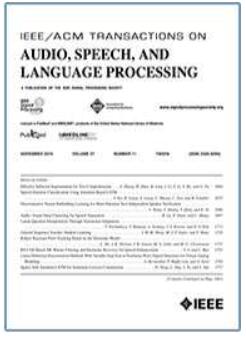从未记录的语音中自动检测不流畅语句
IF 5.1
2区 计算机科学
Q1 ACOUSTICS
IEEE/ACM Transactions on Audio, Speech, and Language Processing
Pub Date : 2024-10-23
DOI:10.1109/TASLP.2024.3485465
引用次数: 0
摘要
说话不流畅,如停顿或重复,是典型语流的中断。所有说话者有时都会出现语无伦次的情况,某些说话者或环境特征可能会增加我们产生语无伦次的速度。对不连贯现象进行建模已被证明对一系列下游任务有用,因此,不连贯现象检测有许多潜在的应用。在这项工作中,我们研究了语言、声学和多模态方法,用于帧级不流畅语自动检测和分类。每种方法都依赖音频作为输入。首先,我们评估了几种自动语音识别(ASR)系统转录不流畅语句的能力,衡量标准是不流畅语句错误率。然后,我们将这些 ASR 转录结果作为基于语言的不流畅检测模型的输入。我们发现,不流畅语检测性能在很大程度上受到转录本和对齐质量的限制。我们发现,无需转录作为中间步骤的声学方法优于 ASR 语言方法。最后,我们提出了多模态架构,发现这种架构比单模态方法更能提高不流利检测性能。最终,这项工作为自动帧级不流畅和分类引入了新方法。从长远来看,这将有助于研究人员将不流畅自动检测纳入一系列应用中。本文章由计算机程序翻译,如有差异,请以英文原文为准。
Automatic Disfluency Detection From Untranscribed Speech
Speech disfluencies, such as filled pauses or repetitions, are disruptions in the typical flow of speech. All speakers experience disfluencies at times, and the rate at which we produce disfluencies may be increased by certain speaker or environmental characteristics. Modeling disfluencies has been shown to be useful for a range of downstream tasks, and as a result, disfluency detection has many potential applications. In this work, we investigate language, acoustic, and multimodal methods for frame-level automatic disfluency detection and categorization. Each of these methods relies on audio as an input. First, we evaluate several automatic speech recognition (ASR) systems in terms of their ability to transcribe disfluencies, measured using disfluency error rates. We then use these ASR transcripts as input to a language-based disfluency detection model. We find that disfluency detection performance is largely limited by the quality of transcripts and alignments. We find that an acoustic-based approach that does not require transcription as an intermediate step outperforms the ASR language approach. Finally, we present multimodal architectures which we find improve disfluency detection performance over the unimodal approaches. Ultimately, this work introduces novel approaches for automatic frame-level disfluency and categorization. In the long term, this will help researchers incorporate automatic disfluency detection into a range of applications.
求助全文
通过发布文献求助,成功后即可免费获取论文全文。
去求助
来源期刊

IEEE/ACM Transactions on Audio, Speech, and Language Processing
ACOUSTICS-ENGINEERING, ELECTRICAL & ELECTRONIC
CiteScore
11.30
自引率
11.10%
发文量
217
期刊介绍:
The IEEE/ACM Transactions on Audio, Speech, and Language Processing covers audio, speech and language processing and the sciences that support them. In audio processing: transducers, room acoustics, active sound control, human audition, analysis/synthesis/coding of music, and consumer audio. In speech processing: areas such as speech analysis, synthesis, coding, speech and speaker recognition, speech production and perception, and speech enhancement. In language processing: speech and text analysis, understanding, generation, dialog management, translation, summarization, question answering and document indexing and retrieval, as well as general language modeling.
 求助内容:
求助内容: 应助结果提醒方式:
应助结果提醒方式:


